Caring for leather, skin and fur
Carole Dignard and Janet Mason
Caring for leather, skin and fur is part of CCI’s Preventive conservation guidelines for collections online resource. This section presents key aspects of managing the care of leather, skin and fur objects in heritage collections based on the principles of preventive conservation and risk management.
Table of contents
- Understanding leather, skin and fur
- Causes of damage to leather, skin and fur and preventive conservation strategies
- Examples of preventive conservation practices
- Bibliography and further reading
Understanding leather, skin and fur
Leather, skins and furs have been used since prehistoric times for making articles such as clothing, blankets and pouches and have been used as covering material for items as diverse as furniture, kayaks, books, boxes or chests. There is a wide range of leathers, skins and furs, all with different qualities and characteristics. Differences include the animal species from which the skins derive and the processing and finishing methods used to make the finished skin, leather or fur product. Condition can vary greatly in part due to these factors.
Species of animal skins
Skins of different animals produce skin products that can vary greatly in look, feel, thickness and strength. In particular, skins of different species have different characteristic surface appearances or “grains,” which are due mainly to variations in the size, density and distribution of hair follicles (Figure 1).
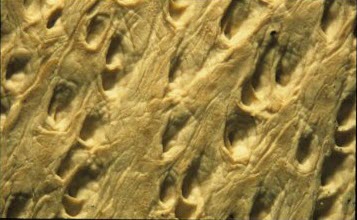
© Government of Canada, Canadian Conservation Institute. CCI 124703-0033
Figure 1. Detail, grain surface of a vegetable-tanned calf leather, 100x magnification.
Animal skins used to make objects found in museum collections are predominantly from mammals, most frequently from domesticated animals such as pig, goat, kid, cow, ox and calf, but also from other species such as bird, fish, snake and reptile. Clothing and other skin and fur objects made by Canadian Indigenous communities (First Nations, Métis and Inuit) are typically made from skins of deer (Figure 2), moose, caribou, bear and seal. Furs of beaver, bison and many other furry mammals are used to make such winter items as coats, capes, stoles and hats.

© Government of Canada, Canadian Conservation Institute. CCI 124703-0034
Figure 2. Painted brain-tanned deer hide.
Skin structure and processing
Skin is largely composed of the long-chained protein called collagen. On a microscopic scale, skin comprises collagen fibres organized in large, long, wavy bundles. The fibres and fibre bundles form a random network, which gives skin its characteristic strength, elasticity and flexibility.
Skin processing consists of a series of steps that are carried out once the skin is removed from the flayed animal in order to cleanse the skin and prevent putrefaction. The choice of processing method used affects the skin’s chemical and water resistance and can modify its strength, toughness, suppleness, flexibility, smoothness and appearance. The hairs and outermost layer of the skin (i.e. the epidermis) are removed at an early stage in the making of leather and skin products. The steps involved in skin processing typically include washing and soaking in various solutions, scraping and mechanical actions, and then working in of oil-based compounds. Skin texture and grain can be significantly enhanced or modified. Artificial grains such as an alligator-type grain can even be impressed onto another type of skin. Tanning, which is one of the last steps in skin processing, consists of adding a tanning agent that chemically binds to the skin protein and improves its stability and durability. Skin that has been tanned has become chemically altered and hence is referred to as leather.
Variety of leathers, skins and furs
Rawhide
The most basic treatment carried out on a flayed skin is to unhair and deflesh the skin mechanically and to dry it on a frame after having washed it or soaked it in water. This produces rawhide (Figure 3), a translucent material that is hard, stiff and tough.
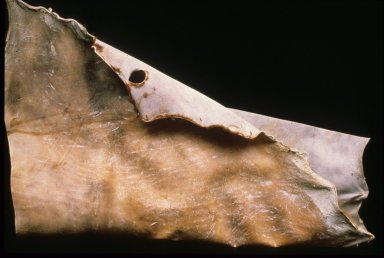
© Government of Canada, Canadian Conservation Institute. CCI 124703-0035
Figure 3. Rawhide.
Rawhide is stable and durable if kept dry, but it is susceptible to moisture, as it contains no added stabilizers (tanning agents). If it becomes wet enough, it will first swell and then will start to putrefy. As rawhide dries, it shrinks, a characteristic that has been used advantageously in the making of objects. For example, wooden boxes may be covered with rawhide in its wet state so that when the hide dries it exerts powerful contracting forces, pulling the wood joints tightly together. Similarly, drumheads are often made of wet rawhide that tightens on drying to produce a taut membrane (Figure 4).
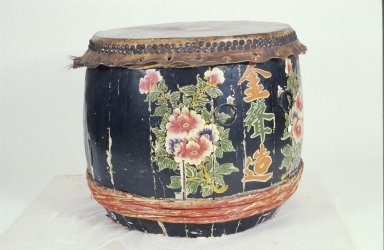
© Government of Canada, Canadian Conservation Institute. CCI 83193-0049
Figure 4. Detail of a gu (Chinese drum) from the Canadian Museum of History, showing the rawhide drumhead fixed to the drum body with a series of rivets.
Other typical rawhide objects include rattles, parfleches, shields and pouches.
Kayak coverings and sealskin floats are made of rawhide that is oiled to make it more resistant to moisture and water (Figure 5).

© Government of Canada, Canadian Conservation Institute. CCI 73692-0290
Figure 5. A model kayak, made of oiled sealskins. From the Mariner's Museum Adney Collection of model canoes and kayaks.
Sinew
Sinew, or tendon, an animal connective tissue that joins a muscle to a bone or other parts, was used by many cultures, including Native American, as a thread or string material in making clothing, drums, kayaks and other skin or fur objects. Its processing basically follows that of rawhide. “Babiche” is a type of lacing made of sinew or of long narrow strips of rawhide used, for example, to make the webbing in snowshoes.
Gut-skin
Membranes from animal internal organs (for example, the cecum, bladder or stomach) processed in a similar way to rawhide produce very thin, translucent “gut-skins” that have been used to make bags or clothing such as Inuit gut-skin parkas (Figure 6). Gut-skins were usually oiled to make them more flexible and water repellent.
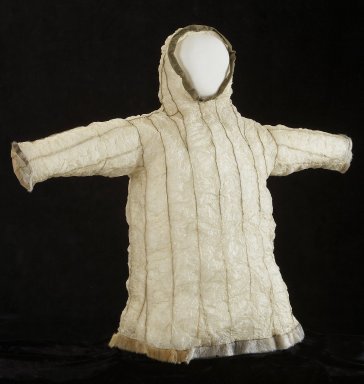
AB 274 Parka, Early 20th century, Bering Sea seal gut, sinew, seal fur; from the Glenbow Museum’s Inuit collection. © Collection of the Glenbow Museum, Calgary
Figure 6. Gut-skin parka.
Parchment and vellum
Parchment and vellum are used extensively for the preparation of manuscripts and as a bookbinding material. They are also used as musical membranes or as a covering material for wooden boxes. The skins of small animals are generally used, particularly calf (for vellum) or goat and sheep (for parchment). After cleaning, the skin is soaked in a lime bath and, while still in a swollen state, is stretched on a frame to dry. Simultaneous stretching and drying cause the skin fibre structure to dry in a “frozen,” stretched state and to be packed more tightly together. The result is a thin, flat and stiff skin. The surface is normally treated with an abrasive, such as pumice, to even out the texture. Various fillers, like chalk, are rubbed in to whiten the skin and make it more receptive to paint and ink.
Semi-tanned skins
Semi-tanning has a very long history and is still used by Indigenous peoples in North America and other peoples, including Australian aborigines and Mongol tribes. The material produced is often called buckskin and is strong and flexible with a soft, suede-like nap and a full plumpness within. It has been used extensively for making pouches or clothing items such as vests, jackets, leggings, mittens, moccasins, etc., often with added decorative elements such as paint, dyed porcupine quills or beadwork (Figure 7).
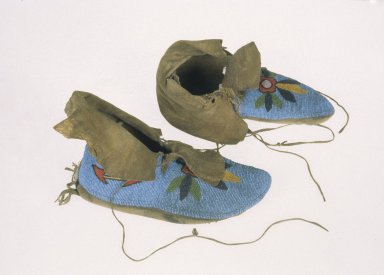
© Government of Canada, Canadian Conservation Institute. CCI 72911-0002
Figure 7. Moccasins from the McCord Museum made of semi-tanned skins extensively decorated with glass beads.
Pre-treatment involves cleaning, soaking in aqueous solutions, and various mechanical actions (flexing, scraping, etc., and sometimes chewing) to soften the skin and work in fatty substances. Indigenous peoples in North America typically work in fat from the brain or spinal column of the flayed animal; such skins are said to be brain-tanned. Bone marrow, egg yolk, milk or butter can also be used. There is little chemical interaction between the oil and the skin protein, and so this is not a tannage in the strict sense.
Brain-tanned skins are often smoked as well, producing a yellow- to amber-brown-coloured skin (Figure 8) with a characteristic smoky smell. Usually, green wood is burned in a low fire with the skin spread around it to form a tent. The smoke reacts chemically with the collagen and partially tans the skin, making it more stable and water-resistant. Oils need to be present in the smoked skin to prevent the fibres from sticking and hardening.
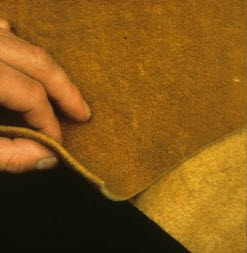
© Government of Canada, Canadian Conservation Institute. CCI 124703-0036
Figure 8. Two skins smoked to different degrees range from yellow to amber in colour.
Black-tanned or iron-tanned skin
Black-tanned or iron-tanned skins are obtained by applying iron-rich mud or water, or a solution made from boiling nails, to semi-tanned skins. This produces a skin of a dark-brown colour. Objects made of black-tanned skins include pouches (Figure 9) and moccasins. Black rot is a form of severe chemical deterioration due to the long-term action of these iron salts present within the skin; the skin then becomes weak and brittle.
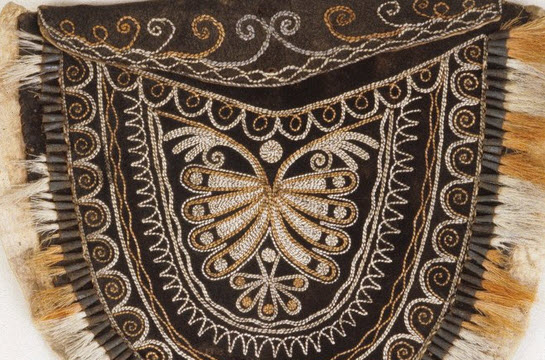
© 2013 President and Fellows of Harvard College, Peabody Museum of Archaeology and Ethnology, 90-17-10/49318
Figure 9. Detail of a Mohawk black-tanned pouch.
Oil-tanned skin (chamois)
Oil tannage is similar to brain tannage, except that the oils typically used react further and create chemical links throughout the skin structure. Fish oil is most often used, particularly cod-liver oil. The modern process involves heating the oiled skin in the range of 30–50°C to effect oxidation and crosslinking of the oil. This reaction prevents the fibres from sticking upon drying and so imparts suppleness. “Chamois” is a well-known product of this process and is used to make gloves, purses and other such objects (Figure 10). Chamois is strong, resistant to water and very absorbent. Oil tanning is also a common process for furs.

© DLM German Leather/Deutsche Schuhmuseum Offenbach. Photograph: Monika Kotthaus
Figure 10. Purses for different sorts of coins, 16th century. Made of chamois leather.
Alum-tawed skin
Alum tawing is an ancient skin-processing method used mostly for making gloves and other personal items (Figure 11). A mixture of potash alum, sodium chloride, egg yolk, flour and water is worked into softened skins. It is not a true tannage, as the salts and other materials applied are not chemically bonded to the skin and can be washed out to some extent. It can therefore be damaged by contact with water. Alum tawing produces a very white material, which is soft and capable of taking a polish but difficult to dye. Alum-tawed skin can also be smoked to increase its durability. The process is also used for dressing fur-skins.

© Government of Canada, Canadian Conservation Institute. CCI 124703-0006
Figure 11. Glove made of alum-tawed skin.
Vegetable-tanned leather
Vegetable tanning is commonly used to make a wide variety of objects, including bags, belts, purses (Figure 12), boots, straps, harnesses, saddles, furniture and vehicle upholstery, painted or gilt wall panels and bookbindings. It is an old technique, used to this day, although mineral tanning, which was introduced at the end of the 19th century, is also now common. Vegetable-tanned leathers retain the impressions formed by tools and so are used to make decoratively tooled items and for fine bookbindings.

© Government of Canada, Canadian Conservation Institute. CCI 124703-0037
Figure 12. Various bags, pouches and a belt made of vegetable-tanned leather.
The basic process involves suspending a prepared skin in tanning liquors consisting of infusions of bark, leaves or twigs in water. The minimum soaking time is two days, but it can be done for a year or more with regular beating and manipulation of the skin. At the end of the process, the leather is hard and inflexible, so fats and oils, such as tallow or cod-liver oil, are worked in to provide flexibility. The tanning process stabilizes the skin to provide a higher degree of resistance to water and wear. The tannins in the bark infusions that bind to the collagen substrate are of two main types: some wood species predominantly have the condensed type of tannins (e.g. mimosa), some have the hydrolysable-type (e.g. sumac) and some have a combination of both (e.g. oak). These different tannin types affect the extent of a vegetable-tanned leather’s resistance, or vulnerability, to inherent chemical degradation (oxidation and acid hydrolysis). In particular, vegetable-tanned leathers can suffer from “red rot,” which is a severe degradation characterized by the leather becoming quite weak and powdery (consult the section Pollutants, red rot for more information).
Mineral-tanned leather and combination tannages
Nowadays, a large part of the world’s supply of leathers is mineral-tanned. Chromium salts are predominantly used, but other salts, such as zirconium, have come into use as well. The salts in the tanning liquor bind strongly to the skin’s collagen and provide crosslinks, creating chemically stable and water-resistant leathers. A fully chrome-tanned leather will not shrink or alter even when exposed to hot water. It is necessary to add a lubricant after tanning before the leather is dried, otherwise it will be stiff. The first modern mineral tanning process, chrome tanning, dates back to about 1884, so only relatively recent museum objects may be made in this way. (Note: the older tanning processes of iron-tanning and alum-tawing [described above] are, technically, also “mineral-tanning.”)
Combinations of the above processing techniques are common. For example, a skin may be vegetable tanned to impart a firm yet flexible structure, followed by mineral tanning to provide higher resistance to water.
Furs
Furs provide an ideal protection against the cold, and their use as clothing and blankets is probably as ancient as the art of hunting. Fur-skins processed as rawhide are generally stiff. Within Indigenous North American cultures, furs are often prepared using semi-tanning processes (brain-tanning with or without smoking) and with extensive scraping and manipulation, resulting in a soft, supple material suitable for clothing. Inuit amauti are prime examples (Figure 13).

© Government of Canada, Canadian Conservation Institute. CCI 124703-0038
Figure 13. A semi-tanned fur-skin parka or amauti. The fur hairs are on the inside.
Other common processing methods for fur-skins include oil-tanning, alum-tawing and pickling. Pickling involves immersing the skin in baths of strong acids and salts; the term “pickling” is used by furriers when the chemical agent used does not confer complete resistance to water, while “tanning” implies a more water-resistant processing treatment. Certain factors or methods when processing a fur-skin are critical for preserving the hairs. These include the time of year the animal was killed, as well as avoiding physical damage to the hairs during the scraping and manipulation, quick cooling, and prompt and thorough cleansing of the skin to prevent bacterial growth that would risk loosening the hairs.
Caution: pesticide residues
Often, fur objects, and to a lesser extent other skin and leather objects, may have been treated with pesticides such as arsenic, mercury and dichlorodiphenyltrichloroethane (DDT) and may pose a health hazard during handling or examination. For more information on this topic, consult CCI Note 1/7 Mercury in Museum Collections.
Causes of damage to leather, skin and fur and preventive conservation strategies
Leather, skin and fur objects can become damaged due to a variety of causes. This section discusses the extent to which leathers, skins and furs are vulnerable to various agents of deterioration, the types of damage that may occur and the preservation strategies that prevent damage.
Physical forces
Physical stresses applied during handling and in-house moves or due to poor support or inadequate storage can result in misshapened, flattened (Figure 14), weakened or even torn leather, skin or fur objects. Objects originally strong, sturdy and flexible, or which were originally made to withstand everyday domestic use, may now be weaker or more brittle and need to be treated with more gentle care. Leathers and skins can have weakened due to chemical degradation reactions (e.g. red rot, black rot), large fluctuations in environmental conditions, water damage, pest activity, or use, abrasion and wear. Thinner skins (e.g. gut-skins, fine gloves) are particularly vulnerable to physical stresses.

© Government of Canada, Canadian Conservation Institute. CCI 124703-0039
Figure 14. Flattened moccasins due to poor storage conditions and lack of support.
Among other more vulnerable types of leathers, skins and furs are those that are stretched: drumheads, skin-covered chests, kayak skins, etc. These should be treated with great care as they are easily torn or punctured if accidentally subjected to even low impacts. For specific information on the care of kayaks and umiaks, consult CCI Note 6/3 Care of Canoes, Kayaks and Umiaks.
Three-dimensional objects such as clothing, pouches, mittens, moccasins and floats are at risk of becoming permanently compressed, creased or deformed unless provided with inner and outer supports that help keep their original shape. Leathers and skins may stiffen if left unused for long periods, which is the normal situation in museums, where manipulation, flexing and use are generally avoided. Misguided attempts to force misshapen objects to regain their shape may lead to tears or distortions. The best solution is, rather, to provide good inner and outer mounts to prevent flattening, loss of shape and permanent creases or deformations (Figures 15, 16 and 17). In storage, trays and boxes provide additional three-dimensional protection.
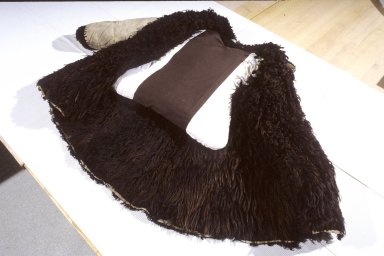
© Government of Canada, Canadian Conservation Institute. CCI 2003598-0001
Figure 15. Sheepskin coat padded out to maintain its shape.
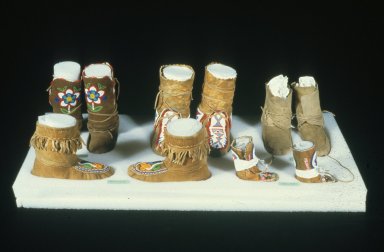
© Government of Canada, Canadian Conservation Institute. CCI 124703-0040
Figure 16. Moccasins with fabric-lined inner foam padding stored within nests carved out of a slab of polyethylene foam. Each nest is lined with soft fabric.
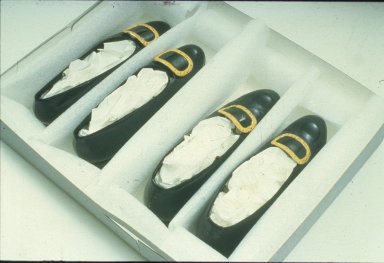
© Government of Canada, Canadian Conservation Institute. CCI 124703-0041
Figure 17. Shoes padded out with tissue paper and protected with smooth foam and a box.
Fragile or damaged objects may be too weak to support their weight; they require form-fitting supports and mounts, as shown in Display mount for fire apparatus suffering from red rot. For fragile objects, it is best to avoid the stresses of direct careful handling; rather, have the object rest in storage in its own tray, base or box so that, at all times, the support is moved instead of the object. In particular, long, thin pieces of hide, such as lashings or whips, may have stiffened and, because of their weight, be vulnerable to breaking if handled or moved without support.
Objects decorated with beads, tinklers and other ornaments
Leather, skin and fur objects with heavy decorative panels (glass beads are especially heavy) are vulnerable to tears and distortions because they may not be able to bear the weight. Tears can result if the item is handled unsupported (Figure 18).
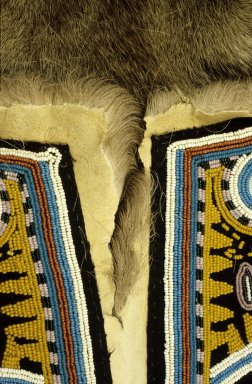
© Government of Canada, Canadian Conservation Institute. CCI 2003208-0001
Figure 18. Detail of tears on a caribou fur beaded garment. The fur-skin, which is quite thin, is weak and cannot support the weight of the dense hair and heavy glass-beaded panels.
Beads, tinklers, sequins, feathers, quills and other decorative elements often attached to skin and leather objects may be at risk of loss during handling and moving because the thread or other means of attachment may now be weak or broken (Figure 19). If glass beads or metal tinklers are corroding, the thread or sinew that is carrying them may be attacked by the degradation products and thus become weak. Also, objects with fringes and thongs may have become worn, stretched or damaged and unable to carry their weight. Objects with any such decorations should generally be stored in boxes or trays to capture any loose elements. To prevent detachments, decorative components should be examined to assess if they need to be locally secured; for example, if they need to be loosely bound with cloth tape. For more information on the care of objects decorated with glass beads, consult CCI Note 6/4 Care of Objects Decorated with Glass Beads.
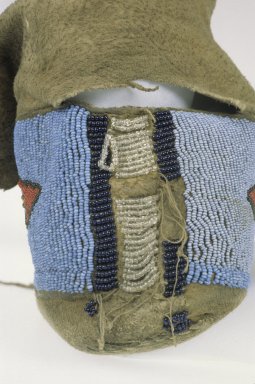
© Government of Canada, Canadian Conservation Institute. CCI 72911-0003
Figure 19. Detail, heel of a moccasin, showing torn stitches and beads at risk of falling during handling.
Fur hair slippage
Furs of the deer family can suffer from hair slippage, which is caused by the loosening of the hair root anchoring system. The exact cause is not well understood, and it is not possible to detect which skin is likely to suffer from this over time or to prevent it from happening. Any handling or movement should be minimized to prevent losses or further dislodging of the hairs.
Loss of flexibility and leather dressings
A common question is whether leather dressings or other oil-based formulas should be applied to restore flexibility to a stiff vegetable-tanned leather. The answer is no. Museum objects are usually not flexed or used to the extent that non-museum pieces are and so do not require the additional flexibility that such oiling imparts. These dressings can be harmful because, in time, oils oxidize and may produce deteriorative effects within the skin structure, such as further stiffening and darkening. Oils and dressings can also lead to sticky surfaces that attract dust and soiling, and to dehydration within the material. An excellent discussion on leather dressings can be found in Leather Dressing: To Dress Or Not To Dress (PDF format), published by McCrady and Raphael (1993). Saddle soap, which contains oils plus a soap element that is also supposed to clean leather, should not be used for the additional reason that these products are alkaline and harmful to leathers, which are naturally acidic in nature.
For more preservation strategies to prevent damage by physical forces, consult Agent of deterioration: physical forces.
Recommendations
- Provide sufficient horizontal and vertical storage space to avoid cramming, compression or creases.
- Ensure no fringe, tinkler and other such decorative component hangs from storage shelves (Figure 20).
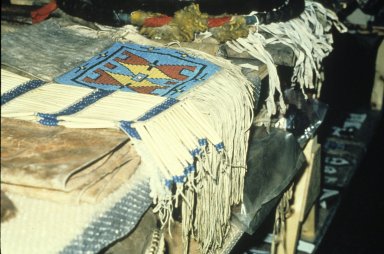
© Government of Canada, Canadian Conservation Institute. CCI 124703-0068
Figure 20. Elements dangling over storage shelves are at risk of loss or damage.
- Inspect decorative components (e.g. tinklers, fringes, beadwork) to identify weak or damaged threads, strings or attachments and secure (e.g. with ties), if necessary. Support and contain objects with decorative components to prevent losses (Figure 21).
- Provide boxes, trays, padding and securing nests or ties for fragile or vulnerable objects on storage shelves or in drawers (Figure 22).
- Provide inner padded supports for rounded objects such as bags, purses, hats, boots, moccasins (Figure 22), gloves, mittens, coats, vests, jackets and leggings. Pad out objects to preserve their three-dimensional shape, but avoid overstuffing, which produces tension and can stretch the skin, loosen stitching or cause weakening and tears. For an example, consult Storage protection for a collection of moccasins.
- Provide padded hangers for items in hanging storage, such as described in CCI Note 13/5 Hanging Storage for Costumes.
- Identify fragile items such as skins or leather suffering from red rot or black rot, or otherwise severely degraded, and provide them with protection (handling tray, box) and supports, for example as in Display mount for fire apparatus suffering from red rot.
- Avoid handling fragile, brittle or stiff objects directly; provide them with supports, padded trays or boxes (Figures 21, 22 and 23).
- Provide temporary trays with padding for use during handling and relocations.
- Identify furs with hair slippage, contain them within boxes or trays and avoid any handling.
- Train staff and volunteers to recognize the most vulnerable objects and how to provide extra care.
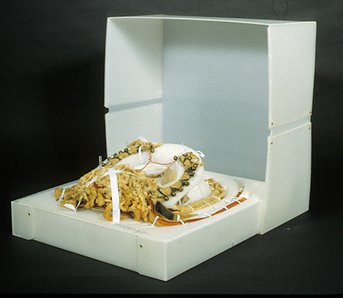
© Government of Canada, Canadian Conservation Institute.
CCI 124703-0042
Figure 21. Ermine fur headdress with many small parts supported with a foam mount, secured with twill tape and contained within a box.
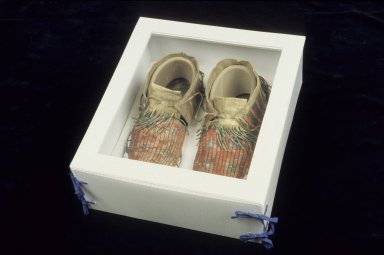
© Government of Canada, Canadian Conservation Institute. CCI 72913-0001
Figure 22. Internal support and padded box for moccasins in the collection of the McCord Museum.
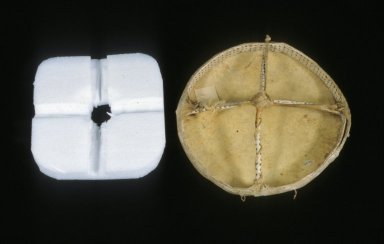
© Government of Canada, Canadian Conservation Institute. CCI 124703-0043
Figure 23. Drum, interior view, with a foam support carved to fit the crossbar handle. Once on its support, the drum can be handled via the foam base.
Thieves and vandals
Thieves and vandals are a risk for any type of object, especially on unprotected display (Figure 24). In particular, the display of fur coats of certain animal species may be controversial in some communities; the risk of damage by protesters should be assessed. Also, political documents, such as charters or constitutions, which are often written on parchment, may be targets for vandals wishing to make a statement. It is worth considering these risks and taking additional security precautions, should the need arise.
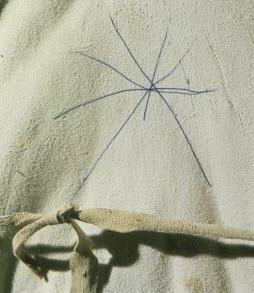
© Government of Canada, Canadian Conservation Institute. CCI 2001191-0001
Figure 24. Pen ink vandalism on a brain-tanned skin vest on unprotected display.
For more preservation strategies to prevent damage by thieves and vandals, consult Agent of deterioration: thieves and vandals.
Dissociation
A type of action resulting in dissociation includes handling, storing, mounting or exhibiting an object or collection in a manner that is disrespectful of the value to certain stakeholders and, hence, results in loss of value. It is important to identify leather, skin and fur objects from Indigenous communities or other groups that may have cultural care requirements and, once identified as such, to respect and implement appropriate measures. For more on culturally sensitive objects and how to properly care for them, consult Caring for sacred and culturally sensitive objects.
Dissociation may occur through loss of evidence, most notably the loss of an accession number tag. As well, small decorative elements such as fringes, tinklers and beads may be at risk of detachment and dissociation during handling (Figure 25). Staff should be aware of this risk and prevent dissociation by using boxes to contain such items, as discussed above under Physical forces. In addition, should detachment occur, staff should know the procedure to follow and have the necessary means (boxes, zip-lock bags, cotton string, etc.; plus an appropriate damage report form) to ensure that the detached element remains with the object, thus remaining identified with the same accession number and provenance.
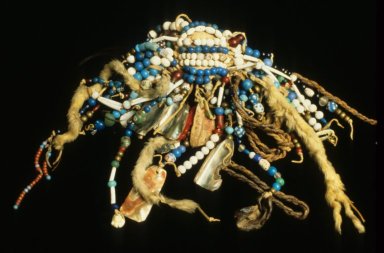
© Government of Canada, Canadian Conservation Institute. CCI 124703-0044
Figure 25. Attachments and small parts such as those on this beaded object may be at risk of becoming detached.
For more preservation strategies to prevent damage by dissociation, consult Agent of deterioration: dissociation.
Fire
Leather, skins and furs are flammable materials, therefore fire is an important risk to address, as discussed under Agent of deterioration: fire.
Water
Most skins and leathers are damaged if in direct contact with water. The degree of damage incurred is largely dependent on the processing and finishing methods used for the skin and on its condition.
- Rawhide, for example, is quite vulnerable. It will swell, soften and putrefy if left in water. Exposed to water, rawhide typically may stiffen, stain, darken and embrittle.
- Parchment and vellum shrink and cockle very badly under exposure to water, as the stretched fibres seek to regain their natural disposition.
- Alum-tawed skins also have very little resistance to water. Wetting causes the salts used in their processing to be washed out, resulting in a hard, horny condition.
- Semi-tanned skin may shrink, stiffen or stain when wetted and allowed to dry (Figure 26). The degree of damage incurred depends on the skin’s condition.
- Although smoke tanning increases the skin’s resistance to water, it is still vulnerable.
- Oiled-tanned skins and chamois have a higher degree of resistance to water damage, compared to semi-tanned skins.
- Vegetable-tanned leather may shrink or stiffen if directly exposed to water. Water may also cause tannins to migrate to the surface, producing staining and surface embrittlement. If affected by red rot, upon wetting, vegetable-tanned leather will harden and darken, even blacken.
- Black-tanned skins, especially those suffering from black rot, may also shrink and harden dramatically if exposed to water.
- Furs have the additional factor of the weight of the fur hair. When wet, the hair can become too heavy for the swollen, weakened skin to bear. This can result in large tears (Figures 27a and b). Skins with heavy glass beaded panels are particularly at risk.

© Government of Canada, Canadian Conservation Institute. CCI 124703-0045
Figure 26. A semi-tanned jacket that has become totally stiff as a result of water damage. Also, at the bottom right, it is stained by mould.
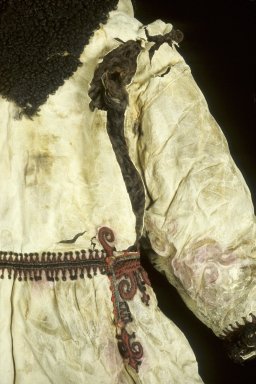
© Government of Canada, Canadian Conservation Institute. CCI 2003598-0002
Figure 27a. A large tear in a sheepskin parka, which occurred as a result of water damage and handling when wet. Water exposure also resulted in the transfer of the red dye on the cuff.
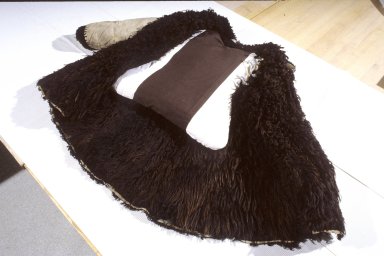
© Government of Canada, Canadian Conservation Institute. CCI 2003598-0001
Figure 27b. After treatment, the sheepskin parka was provided with padding inside the sleeves and for the torso, and with a platform support for safe handling.
For more preservation strategies to prevent damage by water, consult Agent of deterioration: water.
Pests
Mould
Leather, skins and fur objects can be attacked by mould; this is discussed further under Incorrect relative humidity.
Insects
Leathers, skins and furs are nutrients for many species of insects, including dermestids (from the carpet beetle family). Furs are even more prone to infestations because the hair is quite attractive food to some insects, particularly dermestids and moths, and because furs provide shelter where the insects can hide and develop. Soiled or undisturbed objects are most prone to attack. Signs of insect infestations include grazed surfaces, holes (Figures 28a, 28b and 28c) and the presence of frass and casings (Figure 29). In furs, the signs of infestation also include hair loss.
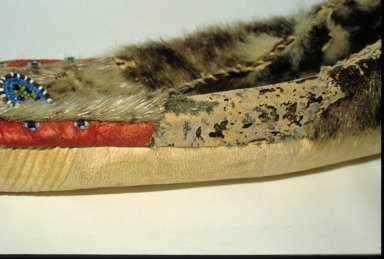
© Government of Canada, Canadian Conservation Institute. CCI 124703-0046
Figure 28a. Result of insect attack on the sealskin fur on a moccasin.
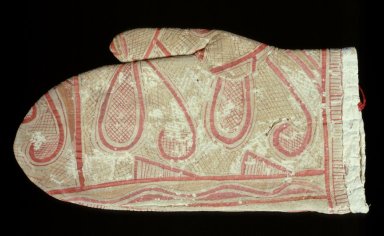
© Government of Canada, Canadian Conservation Institute. CCI 124703-0047
Figure 28b. Innu skin mitten showing damage from attack by dermestid insect. In this case, the insects preferentially attacked the painted areas of the skin.
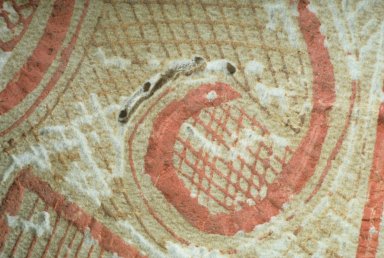
© Government of Canada, Canadian Conservation Institute. CCI 124703-0048
Figure 28c. Detail of Figure 28b. The red paint was probably made of an animal glue binder, which is also an attractive food source for dermestids.
Recommendations
- Implement a full integrated pest management system, including monitoring, housekeeping, building and equipment features.
- For the most pest-prone part of your collection, investigate further preventive treatment options, such as cold storage or anoxic storage, as discussed under Furs: cold storage versus anoxic storage.
- Keep storage areas clean and tidy.
- Keep the collection dust free by using dust covers or enclosures (boxes, storage cabinets, display cases, etc.).
- Quarantine incoming objects before integrating them in the collection.
- Inspect storage areas at least twice a year for signs of insect activity (Figure 29). Inspect objects most vulnerable to infestation twice a year (in spring and fall).
If an infestation occurs, implement basic pest management procedures as outlined in Agent of deterioration: pests under Respond.
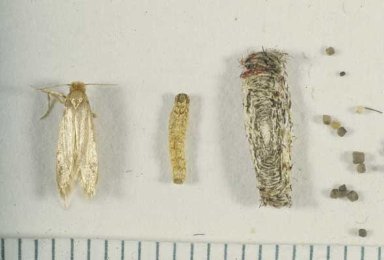
© Government of Canada, Canadian Conservation Institute. CCI 124703-0049
Figure 29. Signs of a moth infestation. From left to right: Carcass of an adult moth; moth larva; moth larva casing; frass.
For more preservation strategies to prevent damage by insects and other pests, consult Agent of deterioration: pests.
Dust and pollutants
Dust
Dust is obtrusive and abrasive and can also increase the risk of infestation. Furs in particular need protection since the hairs trap dust and are difficult to clean. Soiling and staining from dust or hand contact is a general concern, but especially a problem for light-coloured skins, such as brain-tanned skin, and for parchment and vellum.
Pollutants, red rot
Pollutants can cause or significantly affect the oxidation or hydrolysis of skins and leathers. The risk category is ranked in general as moderate to low for most skins and leathers, but will increase the higher the pollution levels. Vegetable-tanned leathers are most vulnerable, more so than alum-tawed skins or rawhide for example, while chrome-tanned leathers are the least vulnerable (Haines 1991). Sulfur dioxide (SO2) is considered the main source of the acidic environment that causes hydrolytic breakdown in leather, while ozone, sulfur dioxide, nitrogen oxides and peroxides are key causes of oxidative breakdown processes. Visible light and ultraviolet (UV) radiation, which can create high-energy free radicals, are also significant factors in initiating oxidation processes. Heat, moisture and the presence of acids or acidic gases also play roles in increasing the rates of both oxidative or hydrolytic breakdown, as well as the presence of metal ions, in particular iron or copper ions (Florian 2006). Sources of metal ion contaminants include iron-based black dyes or mordants, iron-gall ink, some pigments (such as verdigris), blood or rust stains, dust, soiling, metal attachments, or machining and processing impurities.
“Red rot” is a term that refers to the condition whereby vegetable-tanned leather has undergone severe chemical degradation (and not rot, per se, which implies a biological origin) due to inherent tanning compounds as well as atmospheric pollutants [usually sulfur dioxide (SO2)]. Red-rotted leather (Figure 30) is more acidic (typical pH in the range of 3.0-3.5). It is often damaged and worn and has a powdery surface, and physically, it is quite weak and vulnerable to abrasion damage or tearing, especially if improperly supported during handling, storage or display. In the more advanced states, it is noticeably red.

© Government of Canada, Canadian Conservation Institute. CCI 124703-0004
Figure 30. Red rot on leather bookbindings. The leather is quite red, powdery, weak and easily torn.
In the 1930s, when coal was more widely used than today and was the main cause of SO2 pollution in the atmosphere, it was observed in the United Kingdom that leather bookbindings in urban locations were suffering more from red rot than those in cleaner rural settings (Brimblecombe 1996). In Canada, SO2 levels were high in industrialized areas of the country from the start of industrialization up to the 1970s when acid-rain legislations greatly reduced SO2 levels in the air. Many examples of historic vegetable-tanned leather have suffered from SO2 deterioration over time and now are weak and degraded.
Degradation due to metal parts
Stains and chemical weakening of leather, skins and fur-skins can be caused by their oils or by leather dressing applications in intimate contact with metal parts, usually iron or copper or their alloys (Figures 31a and b). The oils attack the metals, and the resulting rust or corrosion products in turn can stain and attack or weaken the skin and leather around it. In the case of copper and its alloys, these corrosion products are typically waxy and green (copper stearate).
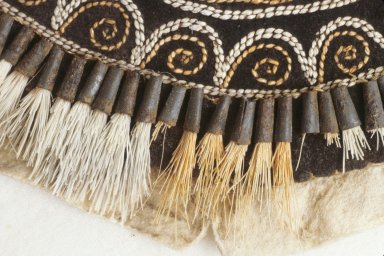
© 2013 President and Fellows of Harvard College, Peabody Museum of Archaeology and Ethnology, 90-17-10/49318
Figure 31a. The iron tinklers on the black-tanned pouch are rusting and causing damage.
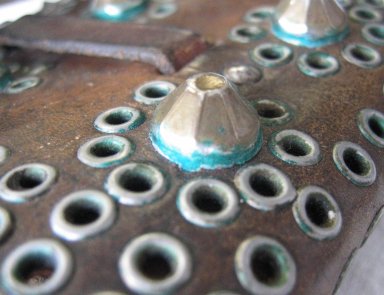
© Government of Canada, Canadian Conservation Institute. CCI 124703-0050
Figure 31b. Brass rivets corroding due to the leather’s oils. The reaction produced a green corrosion product (copper stearate).
Recommendations
- Protect from dust, grime and pollutants using display cases, dust covers, etc. (Figure 32).
- Wear gloves and avoid direct handling to avoid transferring oils or grime from the hands. In particular, take care with parchment, alum-tawed skins and semi-tanned skins as they are easily soiled.
- Measure pollutants levels, assess risks and, if necessary, reduce airborne pollutants.
- Identify all sensitive leather and skin objects, including items suffering from red rot. Provide enhanced pollution protection for these items. For storage, this can include wrapping red rot–affected leather objects in acid-free tissue paper, padded out as required and enclosing them in acid-free, alkaline-buffered boxes.
- Avoid any contact between metals (e.g. shelving, tags, clips) and skins and leathers. Where metal is part of the object and the metal is in contact with the skin or leather, insert a Melinex interleaf or other barrier, if possible. If the metal is actively corroding, consult a conservator for further advice.
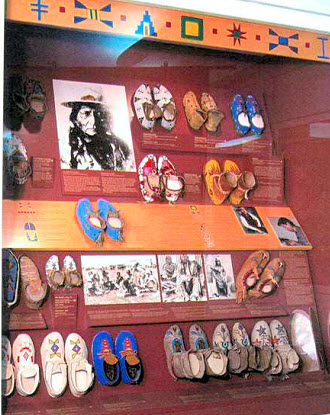
© Canadian Museum of History, 2012-0209-0003-Dm
Figure 32. Moccasins exhibited in a display case. The case protects from dust, vandalism, visitors’ handling and, to some degree, climate fluctuations.
For more preservation strategies to prevent damage by dust and pollutants, consult Agent of deterioration: pollutants and Technical Bulletin 32 Products Used in Preventive Conservation.
Light, ultraviolet and infrared
Decorative elements such as paint, dyes and dyed quillwork ornamentation are often most susceptible to fading due to light or UV radiation, especially those made from traditional plant dyes or the early aniline dyes. Also, the colour of smoke-tanned hides can fade to such a degree that they can be mistaken for a lighter-coloured brain-tanned skin (Figure 33). This fading becomes most noticeable in the case of objects with folds or shielded areas, as the contrast in colours caused by the direct exposure to light is easily seen.

© Government of Canada, Canadian Conservation Institute. CCI 124703-0051
Figure 33. A smoked-tanned skin exposed to various amounts of light. The section on the far left was protected from light and retains its original smoky colour. The centre-left, centre-right and right sections faded progressively as each were illuminated for longer and longer periods. The section on the right was the most exposed and has now lost most of its smoky colour.
Typical sensitivities to fading and discolouration are as follows.
- High sensitivity: smoke-tanning colour, plant dyes (traditional dyes for quillwork), aniline dyes (early synthetic dyes)
- Medium sensitivity: Fur colour, some dyes, some paints
- Low sensitivity: a few dyes, a few paints
- Insensitive: coloured glass beads, charcoal
Specific fading data for some colourants is provided in Agent of deterioration: light, ultraviolet and infrared.
Exposures to high light levels, and especially high levels of UV, can cause, over the long term, photochemical degradation to the collagen skin structure. This results in physical weakening and embrittlement of skins and leathers.
Infrared radiation causes heating and problems such as desiccation within the skin material. As well, distortions and splits can occur due to resulting excessive dryness or to large humidity drops, as discussed further under Incorrect temperature and Incorrect relative humidity.
Recommendations
- Eliminate UV radiation from light sources.
- Protect coloured materials from light, including the smoky colour of smoked-tanned skins.
- Identify light sensitivity levels for objects in the collection, including decorative details.
- For the most light-sensitive objects, adopt strategies to minimize light exposure (e.g. temporary displays, limiting length of time on display, rotation, timers and motion detectors for lights). In storage, keep them in the dark, for example, in opaque containers. Keep some representative objects out of the rotation so that they remain pristine indefinitely, for future research and to make facsimiles.
For more preservation strategies to prevent damage by visible light and ultraviolet radiation, consult Agent of deterioration: light, ultraviolet and infrared.
Incorrect temperature
Temperature has a large impact on relative humidity (RH): a change in 3°C results in a 10% change in RH. Incandescent or other heat-producing lighting can cause localized heating which results in localized low RH; leathers, skins and furs will react physically by losing internal moisture, leading to shrinkage, distortions and possibly tears if the skin or leather is under tension. Because moisture absorption and desorption rates increase with increasing deterioration, the physical damage will be more severe on degraded materials (Larsen 1996). Control strategies for this type of damage are described under the section on Incorrect relative humidity.
In general, all skins, leathers and furs can to some extent degrade chemically at room temperature. Their collagen structure can degrade by oxidation or by hydrolysis. Oils present in leathers and skins also degrade by oxidation. The risk category is ranked in general as moderate to low.
Leathers and skins actively suffering from chemical degradation, such as vegetable-tanned leathers suffering from red rot (characterized by a pH below 4.0) or iron-tanned skins at risk of black rot, are considered to be at high risk of chemical damage at room temperature (i.e. high chemical reactivity at room temperature). Vegetable-tanned leathers in sulfur dioxide polluted environments are also in this high risk category.
The speed with which chemical degradation processes occur is reduced by lowering the ambient temperature. The practical rule of thumb is that a decrease in room temperature of 5°C (for example, from 23 to 18°C) slows down chemical degradation by half, which is a significant benefit. Even larger benefits occur with the implementation of cool ambient temperatures or cold storage. High risk items, as well as deteriorated leathers and skins having very low shrinkage temperature (less than 35°C), are best kept in cold storage to prevent further damage (Larsen et al. 1996). This requires special care and procedures in the bagging and cooling or acclimatization processes to prevent excessive moisture or desiccation as the objects are moved in and out of cold storage. It is worth noting that in a study on a limited number of alum-tawed fur garments and mammal skins, exposure to cold temperatures produced a small loss of moisture regain in some samples and some possible salt migration (Pool 1997). A discussion on the pros and cons of cold storage for a fur collection is provided in Fur: cold storage versus anoxic storage. Anoxic storage, commonly used to prevent infestations, has the additional benefit of being an alternative means of arresting chemical oxidative degradation at room temperature (and is used for this purpose to protect degrading plastics and rubber, for example); however, hydrolytic degradation of leathers and skins would not be hindered.
For more preservation strategies to prevent damage caused by temperature, consult Agent of deterioration: incorrect temperature.
Incorrect relative humidity
Relative humidity over 65%
An RH above 65% is favourable for mould to grow on leather, skins, furs and parchment. The higher the RH, the faster the mould outbreak occurs. Limited air circulation increases the risk of an outbreak. Mould growth appears as web-like white deposits; white, green, grey or black powdery deposits (Figure 34a); and black dots or stains (Figure 34b; also Figure 26). Other symptoms of mould growth may include a mouldy smell. Ultimately, if the mould is allowed to grow, it will attack the structure and weaken it. Consult Agent of deterioration: incorrect relative humidity, which provides a chart indicating the rate of mould growth by humidity level.
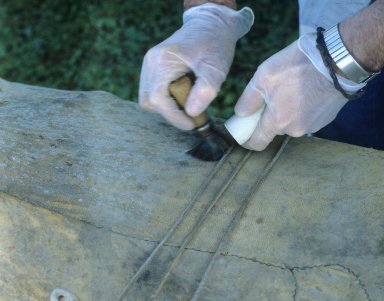
© Government of Canada, Canadian Conservation Institute. CCI 124703-0069
Figure 34a. Green mould deposits undergoing cleaning on a kayak.
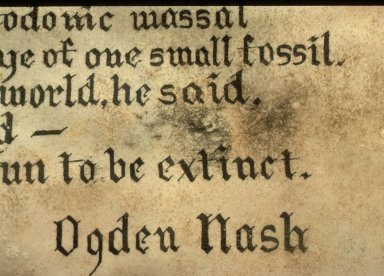
© Government of Canada, Canadian Conservation Institute. CCI 124703-0052
Figure 34b. Detail of a parchment document stained with mould.
For more on how to deal with a mould outbreak, consult Mould outbreak – an immediate response.
In the case of vegetable-tanned leathers, prolonged warm and moist conditions can cause darkening of the surface colour, stiffening and embrittlement, as well as an increase in hydrolytic breakdown (Calnan 1991).
Relative humidity fluctuations
If exposed to a change in RH, skins, furs and leathers will react accordingly by losing or gaining internal moisture, leading to shrinkage or swelling and distortions. Leathers and skins are among the fastest organic materials to react physically to RH changes.
Parchment and vellum, as well as other thin skins and leathers, are most reactive. If exposed to a large increase in RH, for example, parchment and vellum will cockle severely, which can be very disfiguring and difficult to correct. They require stable RH and should be kept well-protected with boxes, mats and display cases so as to mitigate RH fluctuations.
Large changes in RH are also problematic for objects made of stretched or taut leathers or skins, such as drums and kayaks (Figures 35a and 35b), or other such objects where leathers or skins are constrained by being tacked down or stitched to a base (e.g. bookbindings, painted screens and leather-covered chests [Figure 36a]). Even moderate changes in RH can lead to splitting and tearing. Whether damage will occur depends on the object’s previous exposures to extreme RH, as well as on the condition of the leather or skin and the toll taken due to other degradation mechanisms.
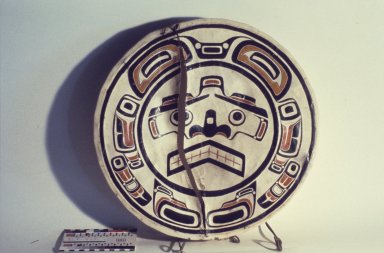
© Government of Canada, Canadian Conservation Institute. CCI 124703-0070
Figure 35a. The large split in this drum membrane was likely caused by a large
RH drop.
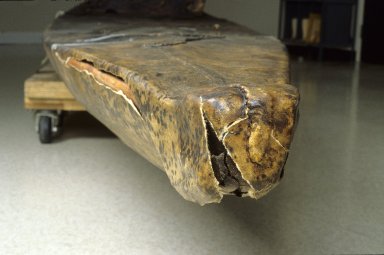
© Government of Canada, Canadian Conservation Institute. CCI 2005089-0001
Figure 35b. The large split in the bow of this kayak was also likely caused by a large RH drop.
Because moisture absorption and desorption rates increase with increasing chemical deterioration, leathers and skins in poor condition will be more quickly or more severely damaged (Larsen 1996).
Sensitivities for specific objects are estimated as follows:
Very high sensitivity: the below-listed items which are also chemically degraded.
High sensitivity: parchment and vellum; skins or leathers that are stretched, fixed, attached at points or attached non-uniformly, such as kayaks, drums or chests (Figures 36a and 36b), and which were not already exposed to wide RH fluctuations; and the paint layer of some painted skins and leathers.
Medium sensitivity: skins, furs or leathers that are restrained uniformly and not highly degraded, such as leather glued uniformly to book boards; thin, well-adhered paint layers of painted skins and leathers.
Low sensitivity: skins, furs or leathers that are free to expand and contract without restraint. (If such objects have painted designs, the attachment of the paint layer is of medium to high sensitivity.)
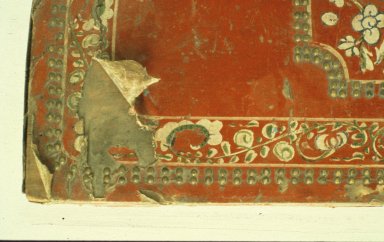
© Government of Canada, Canadian Conservation Institute. CCI 124703-0053
Figure 36a. Detail of a chest made of wood with painted leather secured with rivets. The chest was on display in a historic house and exposed to indoor dryness during the winter months. During Canadian winters, low RH in heated interiors can reach 5% if humidification is absent. This resulted in splits and tears in the leather, as it was restrained from shrinking.
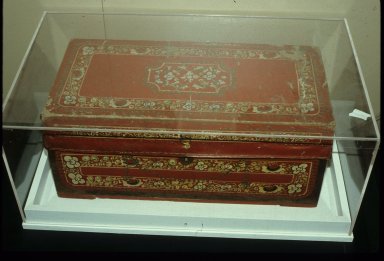
© MacBride Museum of Yukon History Collection
Figure 36b. The chest, after treatment, was provided with a display case to protect it from new damage. The display enclosure creates a more isolated climate within the case, thus reducing the risks of the skins tearing or splitting. The case also provides additional benefits such as protection from dust, water leaks, vandalism, and from potential handling by visitors (thus preventing the risk of small losses and tears, surface abrasion and soiling, etc.).
For more information on the risk incurred to collections due to RH fluctuations, consult the related section within Agent of deterioration: incorrect relative humidity.
Recommendations
- Assess the different sensitivity levels of your skin, leather and fur collection to the various RH risks, including the sensitivity to various ranges of RH fluctuations, and choose appropriate levels of control (consult Table 2 in Agents of deterioration: incorrect relative humidity).
- Avoid large RH deviations with respect to normal stable conditions. Monitor to detect these occurrences, so as to eliminate if possible.
- Keep the most susceptible objects in environmentally stable areas of the building.
- In storage, wrap or cover objects with humidity-buffering materials such as cotton or acid-free (non-buffered) tissue. For furs and other objects susceptible to pest infestations, full wrapping need not be provided if the priority is to have the object sealed within a transparent plastic bag so as to allow easy visual inspection. Place wrapped objects in boxes, enclosures or cabinets to further help slow down and buffer changes in RH. The more layers and enclosures, the better the protection.
- Use well-sealed display cases (Figure 36b).
- Take extra precautions in handling in dry environments (below 30% RH) because loss of moisture may lead to loss of flexibility and risk of physical damage.
- Provide good air circulation.
- Avoid damp conditions due to the high risk of mould growth. Monitor with alarms for RH above 65%, and prepare an action plan to respond to such circumstances, such as trained personnel and equipment to increase ventilation or to dehumidify.
For more preservation strategies to prevent damage caused by RH, consult Agent of deterioration: incorrect relative humidity.
Examples of preventive conservation practices
This section provides practical examples in the care of leather, skin and fur objects.
Storage protection for a collection of moccasins
Several pairs of moccasins in storage at the McCord Museum were in a flattened state (possibly in this state since their accessioning in the collection; Figure 37a). Flexible skin and leather objects, such as bags, mittens, gloves, footwear and garments, cannot hold their shape without support and are at risk of being accidently compressed or of setting with time into a deformed shape. Additionally, small decorative elements, such as quillwork, beads and tassels that may be loose from wear or insect attack, are at risk of being lost if handled or moved without a box or a tray support.
Solution (Figures 37b to 37d): After conservation treatment by a professional conservator involving humidification and reshaping, the moccasins were padded with inner supports and provided with a protective storage enclosure. The inner supports were made of materials strong enough to maintain the shape, but soft enough to allow easy insertion into, and removal from, the delicate skin vamps. These inner supports are neatly finished so as to be kept in the object at all times, whether during storage or on display. For each set of moccasins, a box was made as protection during storage against dust, direct handling and other possible physical stresses. Contoured bases within each box are shaped as shallow nests to prevent movement when the moccasins are handled or displaced.
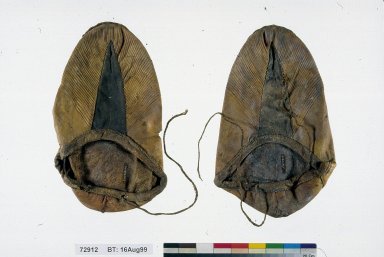
© Government of Canada, Canadian Conservation Institute. CCI 72912-0001
Figure 37a. Moccasins, flattened.
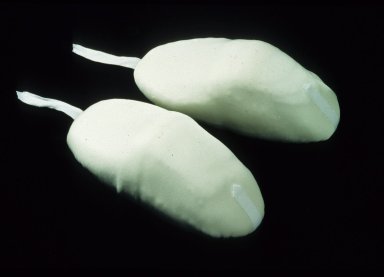
© Government of Canada, Canadian Conservation Institute. CCI 72912-0003
Figure 37b. Inner supports were made of carved polyethylene foam padded with polyester quilt batting and covered with a jersey knit. Twill tape tabs at the heels facilitate the removal of the inner supports when required.
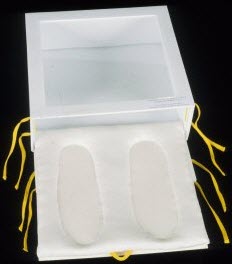
© Government of Canada, Canadian Conservation Institute. CCI 72912-0004
Figure 37c. Example of the Corex box made to enclose the moccasins. The box’s padded base is made by layering polyester felt and/or batting, covering with jersey knit and stitching around the perimeter of the moccasin silhouette to maintain the shape. Twill tape ties are used to close the flaps, and a Melinex window allows easy identification and viewing.
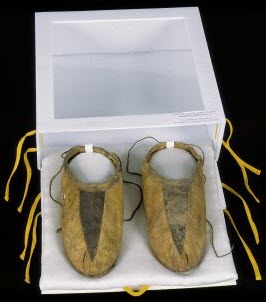
© Government of Canada, Canadian Conservation Institute. CCI 72912-0002
Figure 37d. Using the Corex custom box, the moccasins can easily be viewed and stored without having to handle them.
Display mount for fire apparatus suffering from red rot
A historic breathing apparatus used by firefighters was required for display, and the vegetable-tanned leather that made up its mask was suffering from red rot. This degradation had caused it to become extremely weak, leading to numerous splits and tears as a result of the constant weight of the heavy metal parts (Figure 38a).
Solution (Figures 38a to 38c): After treatment, the leather is repaired but remains fragile. It can sustain its own weight when resting on its inner metal frame, but it cannot sustain the weight of the external, heavy metal and glass parts. An inner foam support and an acrylic display mount were made to support and distribute the weight so as to relieve stresses on the weak leather.
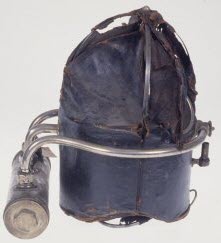
© Government of Canada, Canadian Conservation Institute. CCI 2005329-0001
Figure 38a. Leather breathing apparatus from the Ontario Fire College Museum, before treatment, showing extensive tears due to red rot degradation.
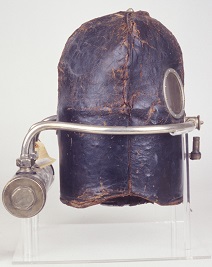
© Government of Canada, Canadian Conservation Institute. CCI 2005329-0002
Figure 38b. After treatment, the leather breathing apparatus is further protected by a secure display and storage mount made of Plexiglas supporting the heavy metal parts. For displacements, the mount (with the object on it) can be handled, rather than having to handle the object directly.
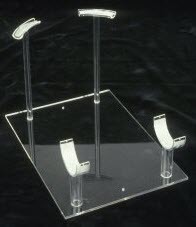
© Government of Canada, Canadian Conservation Institute. CCI 2005329-0003
Figure 38c. The Plexiglas mount for the leather breathing apparatus, with white felt padding positioned in areas that are to be in contact with the metal parts.
Furs: cold storage versus anoxic storage
A case study by Rosalie Scott, Conservator, Prince of Wales Northern Heritage Centre (PWNHC), Yellowknife, Northwest Territories
The cold storerooms that were housing the PWNHC fur collection could not accommodate additional fur objects that were being prepared for transfer to Nunavut due to limited space availability. This situation prompted an assessment of cold storage versus alternative methods such as anoxic storage.
Cold storage
The PWNHC has practised the cold storage method for a collection of fur garments for many years following specific parameters (fur vault temperature of 4°C, RH 50–60%, good air circulation and back-up control system; Figure 39). The objects are stored wrapped in layers of buffering material and sealed in plastic bags, with minimal air entrapped that could cause condensation problems (Figure 40). Since the objects continue to be accessed, the environmental standard for the cold room’s temperature was recently changed from 4°C to 10°C to minimize the potential problems from condensation or acclimatization when the materials are removed from the cold to the regular (room temperature) storage unit.

© Prince of Wales Northern Heritage Centre (PWNHC), Yellowknife.
Figure 39. Cold storage unit with Dryomatic dehumidification unit on top, external monitoring device and controls to the right of the door.
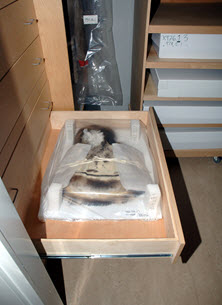
© Prince of Wales Northern Heritage Centre (PWNHC), Yellowknife.
Figure 40. Interior view of PWNHC cold storage. The room incorporates hanging, drawer and shelf storage.
Objects need to be bagged before they are moved from cold storage to room temperature so that moisture does not condense on the cool surface of the object. Objects can be bagged before going into cold storage, but there is a potential for condensation forming on the inside surface of the bag. The amount of moisture will depend on the RH of the environment the object was bagged in and the change in temperature. The objects are wrapped with cloth or tissue paper to absorb this moisture. Bagged objects need to warm to room temperature before being opened.
Benefits of cold storage
- Effective in preventing insect infestation or activity since insects are basically inactive or dormant at cold temperatures. Note that cold storage above freezing point is not intended to actually kill pests. Integrated pest management (which involves inter-coordinated processes such as examination, isolation, monitoring and freezing) is required for full control.
- Cold temperatures reduce inherent chemical degradation of skins and organic materials.
Drawbacks of cold storage
- Potential for slight moisture loss in materials that may only be partially regained. Pool (1997) carried out a study on a limited number of alum-tawed samples and found a loss of moisture regain and possible salt migration.
- Bagging system required for artifacts also requires additional staff time if objects need to be accessed (risk of bags being opened and not resealed).
- Acclimatization to room temperature is required. This procedure is posted on the cold-storage door and is being followed by staff. The new ambient storeroom conditions of 10°C reduce the potential for condensation formation when objects are removed from the cool storage room.
- RH is difficult to control in storerooms because the system is an old unit. This may lead to excessively high or low RH and problems resulting from these conditions.
- System failure can result in high RH. This has happened twice in 17 years of monitoring.
- An alarm system and an adequate response require personnel (the alarm and external monitoring system are presently in place). If either fail, the risk of damage to objects is high, causing mould, water damage, skin degradation, weakening or possible stains from running dyes.
- There are ongoing costs to maintain the system.
Anoxic storage
Anoxic storage (Figures 41 and 42) consists of depleting the oxygen locally around the object to such an extent that insects cannot survive (because they need to breathe). PWNHC’s assessment of the anoxic storage alternative was based on the guidelines provided by Burke (1996). Specialized laminate barrier film (e.g. Escal) is suggested as a transparent, long-term application barrier film. Bagging would be adjusted for 20% decrease in volume since the most feasible (e.g. cost-effective, non-labour-intensive) protocol for PWNHC is to use air without diluting it with nitrogen.
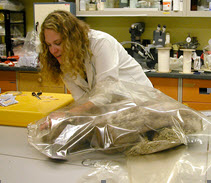
© Prince of Wales Northern Heritage Centre (PWNHC), Yellowknife.
Figure 41. Fur garment being prepared for anoxic storage.
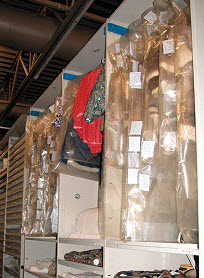
© Prince of Wales Northern Heritage Centre (PWNHC), Yellowknife.
Figure 42. Anoxic storage for furs in the collection. Items are individually bagged and provided with an anoxic environment by means of special oxygen-absorbing pouches.
Benefits of anoxic storage
- Higher efficiency since effective both in preventing insect infestation and in killing insects.
- Lack of oxygen will decrease oxidative degradation of furs and other organic materials. This benefit is greater than the reduced chemical activity from cold temperatures.
- Bagged objects can be stored in the main collection store room, kept at 50% RH and 20°C. No special storeroom is needed, allowing flexibility in where objects can be stored.
- A non-mechanical system eliminates having to respond promptly to any system failure and does not require energy consumption.
- Less demand in staff time:
- low in maintenance time since this is a passive system (e.g. no alarms, no monitoring, no mechanical maintenance required);
- low in training and procedural time since there is no acclimatization required; and
- no temperature differential to deal with, thus more immediate access and no down time for acclimatization.
- Access is a minor issue in this case since the Nunavut materials do not require access as they are only temporarily being housed at the PWNHC in view of transfer to Nunavut. Nevertheless, when required, accessibility is limited because of the bagging and wrapping involved in anoxic storage, but it is improved over cold storage access as there is no need to acclimatize the object to room temperature. Bags can be constructed with extra length so, if needed for examination, the bag can be opened along the seal and then resealed close to the old join. With several extra inches of bag, it could possibly be opened and resealed several times, but oxygen scavengers would need to be replaced after every opening.
Drawbacks of anoxic storage
- Initial costs are high; maintenance costs are low to medium (oxygen scavenger and bag replacements).
- Initial outlay for materials and insertion of oxygen scavenger whenever bag is sealed may slow handling of objects for essential examination.
- Time required to construct bags for each object.
Conclusion
The above considerations led to the decision to store the Nunavut collection using anoxic storage.
Bibliography and further reading
Bibliography
- Brimblecombe, P. “Pollution Studies.” In Environment Leather Project: Deterioration and Conservation of Vegetable Tanned Leather. Protection and Conservation of the European Cultural Heritage, Research Report No. 6. Copenhagen, Denmark: The Royal Danish Academy of Fine Arts, 1996, pp. 25-31.
- Burke, J. “Anoxic Microenvironments: A Simple Guide.” SPNHC Leaflets 1,1 (Spring 1996), pp. 1–4.
- Calnan, C. “Ageing of Vegetable Tanned Leather in Response to Variations in Climatic Conditions.” In Christopher Calnan and Betty Haines, eds., Leather: Its Composition and Changes with Time. Northampton, United Kingdom: The Leather Conservation Centre, 1991, pp.41–50.
- Godfrey, I.M. “Leather.” In D. Gilroy and I. Godfrey, eds., A Practical Guide to the Conservation and Care of Collections. Perth, Australia: Western Australian Museum, 1998, pp. 23–32.
- Haines, B. “Deterioration under Accelerated Ageing Conditions.” In C. Calnan and B. Haines, eds., Leather: Its Composition and Changes with Time. Northampton, UK: The Leather Conservation Centre, 1991, pp. 80–87.
- Haines, B. “Natural Ageing of Leather in Libraries.” In C. Calnan and B. Haines, eds., Leather: Its Composition and Changes with Time. Northampton, UK: The Leather Conservation Centre, 1991, pp.66–74.
- Hawks, C.A., S.L. Williams and J.S. Gardner. “The Care of Tanned Skins in Mammal Research Collections.” Museology 6 (1984).
- Larsen, R. “Moisture Absorption and Release.” In Environment Leather Project: Deterioration and Conservation of Vegetable Tanned Leather. Protection and Conservation of the European Cultural Heritage, Research Report No. 6. Copenhagen, Denmark: The Royal Danish Academy of Fine Arts, 1996, pp. 169–170.
- Pool, M.A. “Preliminary Analysis of the Effects of Cold Storage on Fur Garments and Mammal Skins.” Collection Forum 13,1 (1997), pp.25–39.
- Stone, T., and J. Mason. Care of Canoes, Kayaks, and Umiaks, revised. CCI Notes 6/3. Ottawa, ON: Canadian Conservation Institute, 2010.
- Tétreault, J. Products Used in Preventive Conservation. Technical Bulletin 32. Ottawa, Ontario: Canadian Conservation Institute, 2017.
Further reading
- Canadian Conservation Institute (CCI). Care of Alum, Vegetable, and Mineral Tanned Leather. CCI Notes 8/2. Ottawa, ON: Canadian Conservation Institute, 1992.
- Canadian Conservation Institute (CCI). Care of Rawhide and Semi-Tanned Leather. CCI Notes 8/4. Ottawa, ON: Canadian Conservation Institute, 1992.
- Florian, M.E. “The Mechanisms of Deterioration in Leather.” In M. Kite and R. Thompson, eds., Conservation of Leather. Oxford, UK: Buttterworth-Heinemann, 2006, pp. 36–57.
- Kite, M., and R. Thomson, eds. Conservation of Leather and Related Materials. Burlington, Massachusetts: Butterworth-Heinemann, 2006.
- Larsen, R. “Recommendations on the Production, Artificial Ageing, Assessment, Storage and Conservation of Vegetable Tanned Leathers.” In Environment Leather Project: Deterioration and Conservation of Vegetable Tanned Leather. Protection and Conservation of the European Cultural Heritage, Research Report No. 6. Copenhagen, Denmark: The Royal Danish Academy of Fine Arts, 1996, pp. 189–199.
- McCrady, E., and T. Raphael. Leather Dressing: To Dress Or Not To Dress (PDF format). Conserv O Gram 9/1 (July 1993).
- Stone, T., and C. Dignard. Care of Mounted Specimens and Pelts , revised. CCI Notes 8/3. Ottawa, ON: Canadian Conservation Institute, 1984.
- Storch, P.S. “Skin and Skin Products.” In S. Ogden, ed., Caring for American Indian Objects. St. Paul, Minnesota: Minnesota Historical Society Press, 2004, pp. 113–118.
© Government of Canada, Canadian Conservation Institute, 2018
Published by:
Canadian Conservation Institute
Department of Canadian Heritage
1030 Innes Road
Ottawa, ON K1B 4S7
Canada
Cat. No.: CH57-4/6-6-2018E-PDF
ISBN 978-0-660-27977-0